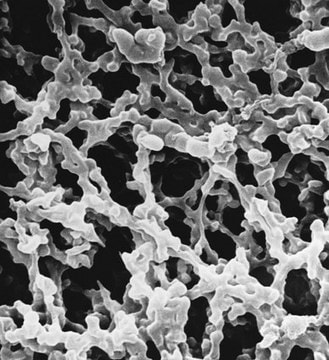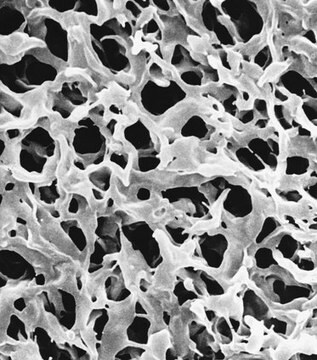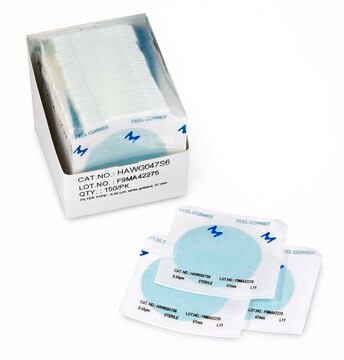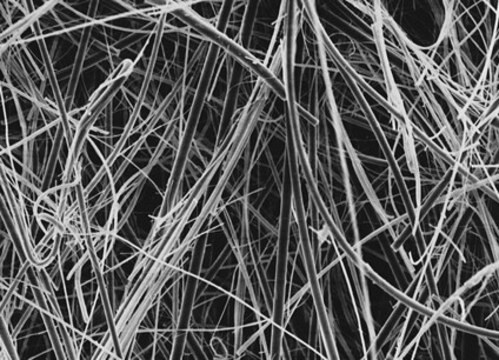おすすめの製品
物質
glass fiber membrane
plain filter
white filter
品質水準
詳細
1.2 µm pore size, hydrophilic glass fiber, 90 mm diameter
特徴
hydrophilic
メーカー/製品名
Millipore
パラメーター
1.2 mL/min-cm2 water flow rate
500 °C max. temp.
フィルタ直径
90 mm
厚さ
240 μm
重量分析抽出物
300%
ポアサイズ
1.2 μm pore size
90 % porosity
輸送温度
ambient
詳細
Filter Code: APFC
Filter Type: デプス フィルター
Overview
Millipore fibrous disc filters are available in a wide range of flow rates and throughput capacities. Our Glass Fiber filters are available with or without binder resins and can be sterilized by EO, gamma, or autoclave (121 °C at 1 bar).
Glass Fiber Filters with Binder Resin:
Millipore filters with binder resin have superior wet strength and are excellent for qualitative analysis and prefiltration, especially for heavily contaminated liquids. They are also widely used for clarification of aqueous solutions.
Type AP15
•Lowest dirt-holding capacity
•Recommended prefilter for 0.2 to 0.6 µm filters
Type AP20
•Lower retention, higher dirt-holding capacity than AP15 filters
•Recommended prefilter for 0.8 to 8.0 µm filters
•Use upstream to protect type AP15 filters
Type AP25
•Added thickness yields same retention and greater dirt-holding capacity as AP20
•Recommended prefilter for 0.9 to 8 µm filters, especially for proteinaceous and heavily contaminated liquids
•Use upstream to protect type AP15 filters
Glass Fiber Filters without Binder Resin:
The filters without binder resin retain their structural integrity without weight loss when heated up to 500 °C and can therefore be used in gravimetric analysis as well as for the filtration of hot gases.
Type APFA
•Retains fine particles with good efficiency, even at high flow rates
•Recommended for monitoring wastewater and collecting suspended particles in gases (e.g., fumes from chimneys)
•Use in biochemical applications (e.g., collection of cells and filtration of protein or nucleic acid precipitates)
Type APFB
•Higher mechanical strength when wet and greater loading capacity than type APFA filters
•Use for liquid clarification, quantification of solids in suspensions of fine particles, and scintillation counting
Type APFC
•Greater retention, especially for fine particulate and microorganism removal than type APFA filters
•Use for determining total suspended solids in drinking water
•Use for filtering proteins or nucleic acid TCA precipitates and for collecting cells and microorganisms
Type APFD
•Thick filter with high flow and low retention
•Use for clarifying suspensions containing particulates greater than 1.0 µm
Type APFF
•Use for filtering extremely fine precipitates such as protein, nucleic acids, or serum precipitates
•Recommended for USEPA method 1311 for TCLP analysis
Type AP40
•Recommended for Standard Methods Total Suspended Solids 2540D
•Recommended for USEPA method 1311 for TCLP analysis
•Maintains structural integrity without weight loss when ignited to 550 °C (1022 °F) after sample filtration
•Recommended for determining volatile suspended matter in wastewater and industrial effluents
Millipore fibrous disc filters are available in a wide range of flow rates and throughput capacities. Our Glass Fiber filters are available with or without binder resins and can be sterilized by EO, gamma, or autoclave (121 °C at 1 bar).
Glass Fiber Filters with Binder Resin:
Millipore filters with binder resin have superior wet strength and are excellent for qualitative analysis and prefiltration, especially for heavily contaminated liquids. They are also widely used for clarification of aqueous solutions.
Type AP15
•Lowest dirt-holding capacity
•Recommended prefilter for 0.2 to 0.6 µm filters
Type AP20
•Lower retention, higher dirt-holding capacity than AP15 filters
•Recommended prefilter for 0.8 to 8.0 µm filters
•Use upstream to protect type AP15 filters
Type AP25
•Added thickness yields same retention and greater dirt-holding capacity as AP20
•Recommended prefilter for 0.9 to 8 µm filters, especially for proteinaceous and heavily contaminated liquids
•Use upstream to protect type AP15 filters
Glass Fiber Filters without Binder Resin:
The filters without binder resin retain their structural integrity without weight loss when heated up to 500 °C and can therefore be used in gravimetric analysis as well as for the filtration of hot gases.
Type APFA
•Retains fine particles with good efficiency, even at high flow rates
•Recommended for monitoring wastewater and collecting suspended particles in gases (e.g., fumes from chimneys)
•Use in biochemical applications (e.g., collection of cells and filtration of protein or nucleic acid precipitates)
Type APFB
•Higher mechanical strength when wet and greater loading capacity than type APFA filters
•Use for liquid clarification, quantification of solids in suspensions of fine particles, and scintillation counting
Type APFC
•Greater retention, especially for fine particulate and microorganism removal than type APFA filters
•Use for determining total suspended solids in drinking water
•Use for filtering proteins or nucleic acid TCA precipitates and for collecting cells and microorganisms
Type APFD
•Thick filter with high flow and low retention
•Use for clarifying suspensions containing particulates greater than 1.0 µm
Type APFF
•Use for filtering extremely fine precipitates such as protein, nucleic acids, or serum precipitates
•Recommended for USEPA method 1311 for TCLP analysis
Type AP40
•Recommended for Standard Methods Total Suspended Solids 2540D
•Recommended for USEPA method 1311 for TCLP analysis
•Maintains structural integrity without weight loss when ignited to 550 °C (1022 °F) after sample filtration
•Recommended for determining volatile suspended matter in wastewater and industrial effluents
アプリケーション
- Removal of fine particles and microorganisms
- Determining total suspended solids
- Filtering proteins or nucleic acid TCA precipitates
- Collecting cells and microorganisms
- Microplastics analysis grade water
- Microplastics analysis
その他情報
Directions for Use
- Organism Retention: Microorganism
- Mode of Action: Filtration (size exclusion)
- Application: General laboratory filtration
- Intended Use: Retention or removal of biological contaminants
- Instructions for Use: Sterilizing filtration of a liquid through a membrane with a 0.2 μm (or smaller) pore size effectively removes biological contaminants, including bacteria, mold and yeast. For the selective retention of larger biological contaminents, liquid filtration through membranes with 0.45 μm (or larger) pore sizes may be used to trap and support microorganism growth for subsequent culture and analysis
- Storage Statement: Store in dry location
- Disposal Statement: Dispose of in accordance with applicable federal, state and local regulations.
保管分類コード
10-13 - German Storage Class 10 to 13
試験成績書(COA)
製品のロット番号・バッチ番号を入力して、試験成績書(COA) を検索できます。ロット番号・バッチ番号は、製品ラベルに「Lot」または「Batch」に続いて記載されています。
ライフサイエンス、有機合成、材料科学、クロマトグラフィー、分析など、あらゆる分野の研究に経験のあるメンバーがおります。.
製品に関するお問い合わせはこちら(テクニカルサービス)



